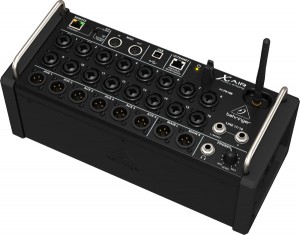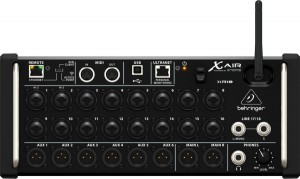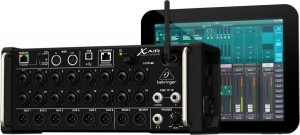Behringer X-Air XR18: the Future of Live Mixing
A few months ago, my trusty old analog mixer that I had used since 2008 developed an intermittent short in one of the aux sends. Unfortunately, this was one of only two pre-fader aux sends on this mixer, so I was using it for one of two monitor sends for band rehearsals and live gigs. This board had a total of 4 aux sends, but two of them are post-fader, and are therefore unsuitable for use as a monitor send.
In any case, after deciding that a repair was going to be more expensive than it was worth, it was time to go shopping for a new mixer. I had a few requirements for a new live board. It needed to be at least a 16-input mixer with built-in digital effects to replace what I already had. I was also hoping to find a board with at least 4 pre-fader aux sends this time, so that each of the 4 guys in my band could have a separate monitor mix, instead of having to share two mixes between 4 guys. After doing a fair amount of research, I discovered that the most affordable mixers with the features that I needed were going to start at around $600 and go on up from there.
After pondering it for a few days, I stumbled across the Behringer XR18. The XR18 was the first in a series of new “X-Air” mixers to be released by Behringer. Each model has the same basic features, with the primary differences being the number of channels, or in the case of the X18, the presence of a tablet dock. This fascinating little box looked like the stage box end of an analog snake, but it had a built-in WiFi router, and get this–it’s a MIXER WITH NO CONTROL SURFACE. Instead, you connect to it wirelessly, and control it with one of a variety of apps for different platforms (Windows, Mac, Linux, Android tablet/phone, or Ipad).
This intrigued me. I had already read some articles about guys mixing their live gigs on a laptop using software mixers such as RME’s TotalMixFX, which is a zero-latency software mixer that’s most often used for headphone monitoring in recording studios in conjunction with RME’s hardware. “What a concept”, I thought. “To have the mixing capabilities of a software mixer, like the one in my DAW (Samplitude Pro X2) for live gigs–wow that would be incredible.”
Then, I started doing some more research and realized people were already doing this using one of a multitude of live mixers already on the market, including the Behringer X32! The X32 had represented a price/performance breakthrough for digital mixers, as it was a joint effort of the engineering teams from Midas, Klark-Teknik, and Behringer. I had admired the X32 from afar, but frankly, it was out of my price range for the number of live gigs that I do. However, as I continued to read up on the XR18, I found out that it was basically a “little brother” to the X32, with a reduced feature set to make it more affordable for folks like me, who wanted to harness the power of digital mixing, but couldn’t afford an X32. It also included a built-in WiFi router (unlike the X32, which requires an external router for remote app control), which meant one fewer piece of hardware for me to lug around to gigs.
Then I realized another reason the XR18 was very appealing to me–it would eliminate the need for any other rack gear: EQ’s, compressors, reverbs, delays, etc. Each input features a comprehensive channel strip with parametric or graphic EQ, compressor, and a noise gate. There are also 4 effects slots that can either be used on the master bus or as inserts, with dozens of effects to choose from for use in each of the 4 slots.
The XR18 can also eliminate the need for an analog snake cable, since you can position the XR18 on the stage while your sound engineer is out front with a laptop, or even walking around the venue with a tablet while making adjustments. So all that a band needs for a powerhouse PA system is an XR18, some powered speakers, or some passive speakers with power amps. The more I thought about this, the more I liked the idea of it.
Oh yeah, there’s one more important feature of the XR18 that I forgot to mention: it also functions as an 18×18 channel USB recording interface, so you can use it to record your live gigs or in your own home studio, eliminating the need for another recording interface!
And here’s what may be the best part: the XR18 sells for less than the price of many analog mixers or recording interfaces (that have a lot fewer features, I might add). I started figuring up how much gear I could replace with a single XR18 (analog mixer, snake, compressors, EQ’s, rack cases, etc.), and figured it would have to be several thousand bucks. I also started thinking about the back-breaking work it would save me when I am loading in and out for a gig. The older I get, the more valuable that seems to me, too!
I ordered the XR18 and within a few days received one of the first batch to hit the market. I downloaded the PC version of the X-Air Edit software to my Dell laptop and found it very easy to use. I also downloaded the Android version of X-Air Edit to my tablet. It’s great for simple adjustments for a band rehearsal, but I would definitely recommend having a laptop available for a real live performance. I found it much easier to dig into the deeper features of the software using the PC version, and the PC version also includes a wealth of processing presets that aren’t available in the Android app. Another nice thing about the software (both platforms) is that you can use it in an “offline mode” when you are not connected to the XR18. This will let you take it for a test drive before buying, or allow you to set up scenes for a show with nothing but your laptop or tablet.
After using the XR18 for a few months, I can’t imagine going back to an analog mixer. The range of features, price/performance ratio, and regular firmware/software updates are going to keep me rocking for at least the next several years. So if you’re in need of a new mixer, definitely check out the X-Air line from Behringer. I guarantee you won’t be disappointed.
Specifications:
- 18-Channel, 12-Bus Digital Mixer for iPad/Android Tablets with 16 Programmable MIDAS Preamps, Integrated Wifi Module and Multi-Channel USB Audio Interface
- iPad/Android tablet controlled 18-input digital mixer for studio and live application
- 16 award-winning MIDAS-designed, fully programmable mic preamps for audiophile sound quality
- Stereo 1/4″ TRS Aux Input
- Built-In Tri-Mode Wifi router for direct operation—no need for external routers
- 18 x 18 channel, bidirectional USB interface for direct recording on iPad etc.
- Revolutionary Dugan-style Auto-Mixing automatically manages microphone gain sharing (future firmware)
- Award-winning X32 effects rack featuring 4 stereo FX slots including high-end simulations such as Lexicon 480L and PCM70, EMT250 and Quantec QRS etc.
- 100-band Real Time Analyzer (RTA) for all channel and bus EQ’s
- ULTRANET connectivity for BEHRINGER’s P-16 Personal Monitoring System
- Rack ears and protection bumpers included for flexible rack and onstage applications
- 6 aux and main LR buses with inserts, full dynamics processing and 6-band parametric or 31-band graphic EQ
- 6 XLR aux outputs and 2 XLR main outputs plus phones connector
- 40-Bit floating-point DSP features virtually unlimited dynamic range with no internal overload and near-zero overall latency
- Free iOS, Android and PC/Mac/Linux apps available for remote operation via Ethernet, LAN or WiFi
- MIDI In/Out allows controlling the mixer via MIDI equipment (incl. Mackie Control protocol) or for use as a USB MIDI interface
- Future firmware updates, including new FX Plug Ins, downloadable from behringer.com free of charge
- Internal switch-mode power supply for noise-free audio and low power consumption
- 3-year warranty
Shop for the Behringer XR18 at ZZounds.com.
 November 30, 2015
|
Posted by Jon (admin)
November 30, 2015
|
Posted by Jon (admin)



 Categories:
Categories:  Tags:
Tags: 